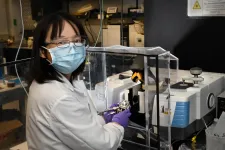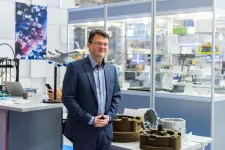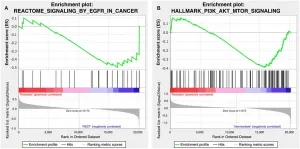(Press-News.org) UPTON, NY--Scientists at the U.S. Department of Energy's Brookhaven National Laboratory, Stony Brook University (SBU), and other collaborating institutions have uncovered dynamic, atomic-level details of how an important platinum-based catalyst works in the water gas shift reaction. This reaction transforms carbon monoxide (CO) and water (H2O) into carbon dioxide (CO2) and hydrogen gas (H2)--an important step in producing and purifying hydrogen for multiple applications, including use as a clean fuel in fuel-cell vehicles, and in the production of hydrocarbons.
But because platinum is rare and expensive, scientists have been seeking ways to create catalysts that use less of this precious metal. Understanding exactly what the platinum does is an essential step.
The new study, published in Nature Communications, identifies the atoms involved in the catalyst's active site, resolving earlier conflicting reports about how the catalyst operates. The experiments provide definitive evidence that only certain platinum atoms play an important role in the chemical conversion.
"Part of the challenge is that the catalyst itself has a complex structure," explained lead author Yuanyuan Li, a research scientist at SBU's Materials Science and Chemical Engineering Department who has a guest appointment in Brookhaven Lab's Chemistry Division and works under the guidance of Brookhaven/SBU joint appointee Anatoly Frenkel.
"The catalyst is made of platinum nanoparticles (clumps of platinum atoms) sitting on a cerium oxide (ceria) surface. Some of those platinum atoms are on the surface of the nanoparticle, some are in the core; some are at the interface with ceria, and some of those are at the perimeter--the outside edges--of that interface," Li said. "Those positions and how you put the particles on the surface may influence which atoms will interact with the support or with gas molecules, because some are exposed and some are not."
Earlier experiments had produced conflicting results about whether the reactions occur on the nanoparticles or at single isolated platinum atoms, and whether the active sites are positively or negatively charged or neutral. Details of how the ceria support interacts with the platinum to activate it for catalytic activity were also unclear.
"We wanted to address these questions," said Li. "To identify the active site and determine what is really happening at this site, it is better if we can investigate this type of catalyst at the atomic level," she noted.
The team, which included scientists from Brookhaven's Center for Functional Nanomaterials (CFN) and other institutions throughout the U.S. and in Sweden, used a range of techniques to do just that. They studied the catalyst under reaction conditions and, unexpectedly, captured a peculiar effect that occurred when the catalysts reached their active state in reaction conditions.
"The platinum atoms at the perimeter of the particles were 'dancing' in and out of focus in an electron microscopy experiment carried out by our collaborators, while the rest of the atoms were much more stable," Frenkel said. Such dynamic behavior was not observed when some of the reactants (CO or water) were removed from the stream of reacting molecules.
"We found that only the platinum atoms at the perimeter of the interface between the nanoparticles and ceria support provide the catalytic activity," Li said. "The dynamic properties at these perimeter sites allow the CO to get oxygen from the water so it can become CO2, and the water (H2O) loses oxygen to become hydrogen."
Now that the scientists know which platinum atoms play an active role in the catalyst, they may be able to design catalysts that contain only those active platinum atoms.
"We might assume that all the surface platinum atoms are working, but they are not," Li said. "We don't need them all, just the active ones. This could help us make the catalyst less expensive by removing the atoms that are not involved in the reaction. We believe that this mechanism can be generalized to other catalytic systems and reactions," she added.
Experimental details
Electron microscopy "snapshots" at the CFN and at the National Institute of Standards and Technology revealed the dynamic nature of the perimeter platinum atoms. "In some images, the perimeter site is there, you can see it, but in some images it is not there. This is evidence that these atoms are very dynamic, with high mobility," Li said.
Infrared (IR) spectroscopy studies in Brookhaven's Chemistry Division revealed that the appearance of the perimeter sites coincided with "oxygen vacancies"--a kind of defect in the cerium oxide surface. These studies also showed that CO tended to migrate across the platinum nanoparticle surface toward the perimeter atoms, and that hydroxy (OH) groups lingered on the ceria support near the perimeter platinum atoms.
"So it seems like the perimeter platinum atoms bring the two reactants, CO and OH (from the water molecules) together," Li said.
X-ray photoelectron spectroscopy studies in Chemistry revealed that perimeter platinum atoms also became activated--changed from a nonmetallic to a metallic state that could capture oxygen atoms from the OH groups and deliver that oxygen to CO. "This really shows that these activated perimeter platinum sites enable the reaction to take place," Li said.
A final set of experiments--x-ray absorption spectroscopy studies conducted at the Advanced Photon Source (APS) at DOE's Argonne National Laboratory--showed the dynamic structural changes of the catalyst.
"We see the structure is changing under reaction conditions," Li said.
Those studies also revealed an unusually long bond between the platinum atoms and the oxygen on the ceria support, suggesting that something invisible to the x-rays was occupying space between the two.
"We think there is some atomic hydrogen between the nanoparticle and the support. X-rays can't see light atoms like hydrogen. Under reaction conditions, those atomic hydrogens will recombine to form H2," she added.
The structural features and details of how the dynamic changes are connected to reactivity will help the scientists understand the working mechanism of this particular catalyst and potentially design ones with better activity at lower cost. The same techniques can also be applied to studies of other catalysts.
INFORMATION:
Brookhaven Lab's role in this work was funded by the DOE Office of Science (BES). CFN and APS are DOE Office of Science user facilities. Additional collaborating institutions include the University of Illinois, Arizona State University, the University of Maryland, and the KTH Royal Institute of Technology in Stockholm.
Brookhaven National Laboratory is supported by the U.S. Department of Energy's Office of Science. The Office of Science is the single largest supporter of basic research in the physical sciences in the United States and is working to address some of the most pressing challenges of our time. For more information, visit https://www.energy.gov/science/
Follow @BrookhavenLab on Twitter or find us on Facebook.
Related Links
Scientific paper: "Dynamic Structure of Active Sites in Ceria-Supported Pt Catalysts for the Water Gas Shift Reaction"
Media Contacts: Karen McNulty Walsh, (631) 344-8350, or Peter Genzer, (631) 344-3174
A team of Russian scientists from NUST MISIS, Tomsk Polytechnic University (TPU) and Boreskov Institute of Catalysis has suggested a new approach to modifying the combustion behavior of coal. The addition of copper salts reduces the content of unburnt carbon in ash residue by 3.1 times and CO content in the gaseous combustion products by 40%, the scientists found. The research was published in Fuel Processing Technology.
According to the International Energy Agency (IEA), coal is the predominant energy resource used as the primary fuel for power generation. According to reports, coal supplied over one-third of global electricity generation in ...
Oncotarget published "Combination of copanlisib with cetuximab improves tumor response in cetuximab-resistant patient-derived xenografts of head and neck cancer" which reported that HNSCC is frequently associated with either amplification or mutational changes in the PI3K pathway, making PI3K an attractive target, particularly in cetuximab-resistant tumors.
Here, the authors explored the antitumor activity of the selective, pan-class I PI3K inhibitor copanlisib with predominant activity towards PI3Kα and δ in monotherapy and in combination with cetuximab using a mouse clinical trial set-up with 33 patient-derived xenograft models with known HPV and PI3K mutational status and available data ...
Scientists and public health experts have long known that certain individuals, termed "super-spreaders," can transmit COVID-19 with incredible efficiency and devastating consequences.
Now, researchers at Tulane University, Harvard University, MIT and Massachusetts General Hospital have learned that obesity, age and COVID-19 infection correlate with a propensity to breathe out more respiratory droplets -- key spreaders of SARS-CoV-2, the virus that causes COVID-19. Their findings were published in Proceedings of the National Academy of Sciences.
Using data from an observational study of 194 healthy people and an experimental study of nonhuman primates with COVID-19, researchers found that exhaled aerosol particles vary greatly ...
(New York, NY) February 10, 2021 - A research team led by the Icahn School of Medicine at Mount Sinai (Icahn Mount Sinai) has built the first cellular model to depict the evolution of acute myeloid leukemia (AML), from its early to late stages. By using gene editing technologies to alter genes that make cells malignant, the team was able to identify potential therapeutic targets for early disease stages. The study was reported in the journal Cell Stem Cell in February.
The therapeutic targets could be applicable not just to AML but also to the blood cancer myelodysplastic syndrome and clonal hematopoiesis, which is often a preleukemic condition.
"We essentially built from scratch a model of leukemia that characterizes the ...
Global emissions of a potent substance notorious for depleting the Earth's ozone layer - the protective barrier which absorbs the Sun's harmful UV rays - have fallen rapidly and are now back on the decline, according to new research.
Two international studies published today in Nature, show emissions of CFC-11, one of the many chlorofluorocarbon (CFC) chemicals once widely used in refrigerators and insulating foams, are back on the decline less than two years after the exposure of their shock resurgence in the wake of suspected rogue production.
Dr Luke Western, from the University of Bristol, a co-lead author of one ...
When we tear a muscle " stem cells within it repair the problem. We can see this occurring not only in severe muscle wasting diseases such as muscular dystrophy and in war veterans who survive catastrophic limb injuries, but also in our day to day lives when we pull a muscle.
Also when we age and become frail we lose much of our muscle and our stem cells don't seem to be able to work as well as we age.
These muscle stem cells are invisible engines that drive the tissue's growth and repair after such injuries. But growing these cells in the lab and then using them to therapeutically replace damaged muscle has been frustratingly difficult.
Researchers at the Australian Regenerative Medicine Institute at Monash University in Melbourne, ...
Researchers at the Centre for Genomic Regulation (CRG) reveal that newly formed embryos clear dying cells to maximise their chances of survival. It is the earliest display of an innate immune response found in vertebrate animals to date.
The findings, which are published today in the journal Nature, may aid future efforts to understand why some embryos fail to form in the earliest stages of development, and lead to new clinical efforts in treating infertility or early miscarriages.
An embryo is fragile in the first hours after its formation. Rapid cell division and environmental stress make them prone to cellular errors, which in turn cause the sporadic death of embryonic stem cells. This is ...
For nearly a century, scientists have worked to unravel the mystery of dark matter--an elusive substance that spreads through the universe and likely makes up much of its mass, but has so far proven impossible to detect in experiments. Now, a team of researchers have used an innovative technique called "quantum squeezing" to dramatically speed up the search for one candidate for dark matter in the lab.
The findings, published today in the journal Nature, center on an incredibly lightweight and as-of-yet undiscovered particle called the axion. According to theory, axions are likely billions to trillions of times smaller than electrons and may have been created during the Big Bang in humungous numbers--enough ...
What The Study Did: This observational study describes differences in the number of COVID-19 deaths by nursing home racial composition and examines the factors associated with these differences.
Authors: Rebecca J. Gorges, Ph.D., of the University of Chicago, is the corresponding author.
To access the embargoed study: Visit our For The Media website at this link https://media.jamanetwork.com/
(doi:10.1001/jamanetworkopen.2020.37431)
Editor's Note: The article includes funding/support disclosures. Please see the article for additional information, including other authors, author contributions and affiliations, conflict of interest ...
What The Study Did: This article revisits the role of dermatologists in the early HIV/AIDS epidemic for the 40th anniversary of the epidemic.
Authors: Heather Milbar, M.D., M.P.H., of the University of Pennsylvania in Philadelphia, is the corresponding author.
To access the embargoed study: Visit our For The Media website at this link https://media.jamanetwork.com/
(doi:10.1001/jamadermatol.2020.5545)
Editor's Note: Please see the article for additional information, including other authors, author contributions and affiliations, conflict of interest and financial disclosures, and funding and support.
INFORMATION:
Media ...




